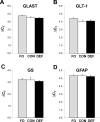Glutamate homeostasis in the adult rat prefrontal cortex is altered by cortical docosahexaenoic acid accrual during adolescence: An in vivo1H MRS study
- PMID: 29049903
- PMCID: PMC5671887
- DOI: 10.1016/j.pscychresns.2017.10.003
Glutamate homeostasis in the adult rat prefrontal cortex is altered by cortical docosahexaenoic acid accrual during adolescence: An in vivo1H MRS study
Abstract
Major psychiatric disorders are associated with dysregulated glutamate homeostasis and deficits in the omega-3 fatty acid docosahexaenoic acid (DHA). This study determined the effects of dietary-induced alterations in brain DHA accrual on cortical glutamate homeostasis in the adult rat brain. Adolescent rats were fed a control diet (n = 20), a n-3 fatty acid-deficient diet (DEF, n = 20), or a fish oil-fortified diet containing preformed DHA (FO, n = 20). In adulthood 1H MRS scans were performed with voxels in the prefrontal cortex (PFC) and thalamus. Compared with controls, erythrocyte, PFC, and thalamus DHA levels were significantly lower in DEF rats and significantly higher in FO rats. In the PFC, but not the thalamus, glutamate was significantly elevated in DEF rats compared with controls and FO rats. Glutamine did not differ between groups and the glutamine/glutamate ratio was lower in DEF rats. No differences were observed for markers of excitotoxicity (NAA, GFAP), or astrocyte glutamate transporter (GLAST, GLT-1) or glutamine synthetase expression. Across diet groups, PFC DHA levels were inversely correlated with PFC glutamate levels and positively correlated with GLAST expression. Together these findings demonstrate that rat cortical DHA accrual during adolescence impacts glutamate homeostasis in the adult PFC.
Keywords: Docosahexaenoic acid (DHA); Glutamate; Glutamate transporter; Glutamine synthetase; Omega-3 fatty acids; Rat.
Copyright © 2017 Elsevier B.V. All rights reserved.
Figures





References
-
- Barceló-Coblijn G, Murphy EJ, Othman R, Moghadasian MH, Kashour T, Friel JK. Flaxseed oil and fish-oil capsule consumption alters human red blood cell n-3 fatty acid composition: a multiple-dosing trial comparing 2 sources of n-3 fatty acid. Am. J. Clin. Nutr. 2008;88:801–809. - PubMed
-
- Beneyto M, Meador-Woodruff JH. Lamina-specific abnormalities of NMDA receptor-associated postsynaptic protein transcripts in the prefrontal cortex in schizophrenia and bipolar disorder. Neuropsychopharmacology. 2008;33:2175–2186. - PubMed
-
- Berry CB, Hayes D, Murphy A, Wiessner M, Rauen T, McBean GJ. Differential modulation of the glutamate transporters GLT1, GLAST and EAAC1 by docosahexaenoic acid. Brain Res. 2005;1037:123–133. - PubMed
-
- Carver JD, Benford VJ, Han B, Cantor AB. The relationship between age and the fatty acid composition of cerebral cortex and erythrocytes in human subjects. Brain Res. Bull. 2001;56:79–85. - PubMed
MeSH terms
Substances
Grants and funding
LinkOut - more resources
Full Text Sources
Other Literature Sources
Medical
Miscellaneous

